Draft Fisheries Assessment – Faroe-Shetland Sponge Belt NCMPA: Fisheries management measures within Scottish Offshore Marine Protected Areas (MPAs)
These assessments look at the fishing activity occurring within each offshore MPA and SAC and assess the potential impacts of this activity on the protected features within each site. This assessment is for Faroe-Shetland Sponge Belt NCMPA.
3. Part B – Fisheries Assessment
3.1 Fisheries Assessment Overview
Part B of this assessment considers if there would be a risk of the fishing activities in part A, at the levels identified in the relevant date range, hindering the achievement of the conservation objectives for the NCMPA. This is in order to consider whether, and if so, which, management measures might be appropriate for the NCMPA, taking into account all relevant statutory obligations incumbent upon the Scottish Ministers.
The fishing activities and pressures identified in Part A which have been included for assessment in Part B, are demersal trawls, demersal seines and anchored nets/lines. The pressures associated with these fishing activities that have been included in Part B are;
- abrasion/disturbance of the substrate on the surface of the seabed;
- changes in suspended solids (water clarity);
- penetration and/or disturbance of the substrate below the surface of the seabed, including abrasion;
- removal of non-target species, and
- smothering and siltation rate changes (light).
3.2 Fishing Activity Descriptions
3.2.1 Existing management of fishing activity within the Faroe-Shetland Sponge Belt NCMPA
The shallowest parts of the Faroe-Shetland Sponge Belt NCMPA are 400 m below sea-level, however depths within the site reach 800 m below sea-level in the Faroe-Shetland Channel.
In compliance with Part 5, Chapter 7 of The Common Fisheries Policy and Aquaculture (Amendment etc.) (EU Exit) Statutory Instrument (S.I.) 2019 No. 753, there is a ban on the use of all bottom-contacting mobile gear below 800 m depth across all UK waters. This applies across the area of the NCMPA where the depth falls below 800 m. Part 5 Chapter 7 of S.I. 2019, No. 753 also implements restrictions on fishing between 400 m and 800 m where Vulnerable Marine Ecosystems (VMEs) are present or are likely to occur. These rules aim to minimise the impact of fishing activities on VMEs. Under The Common Fisheries Policy and Animals (Amendment etc.) (EU Exit) Regulations 2019 S.I. 2019, No. 1312 (amending S.I. 2019, No. 753) there is a prohibition on the use of bottom-set gillnets, entangling nets, and trammel nets at depths greater than 200 m for the protection of deepwater shark species.
3.2.2 Fishing Activity within the NCMPA
The Faroe-Shetland Sponge Belt NCMPA overlaps ICES rectangles 51E6, 51E7, 51E8, 50E5, 50E6, 50E7, 49E5 and 49E6 and sits within ICES Divisions 4a, 5b and 6a. The main gear types for UK vessels are demersal trawls and anchored nets/lines along with a small amount of demersal seine activity.
The VMS-based estimates and ICES rectangle landings statistics indicate that vessels utilising demersal trawls are the predominant UK vessels that operated within the site over the period 2015-2019.
For the over-12 m vessels, based on the VMS data from 2015-2019, demersal trawls and seines occurred at low levels across the central area of the site.
3.2.3 Demersal Trawls
The aggregated gear method of demersal trawls includes the multiple gears that operated within the Faroe-Shetland Sponge Belt NCMPA between 2015 and 2019. These include bottom otter trawls and multi-rig trawls (Table 1).
The target species for these gear types are demersal fish. Similar pressures are exerted by the different gears used for demersal trawling, subsequently the aggregated gear type of ‘demersal trawl’ was used to map activity across the site.
Based on the VMS, the highest intensity of demersal trawl activity within NCMPA occurs in a central band through the middle of the site, with a slightly higher level of activity occurring to the south west of the site with activity peaking at 24-28 hours per grid cell per year (2015-2019), (Figure 2). The majority of the site has lower fishing intensity (less than 12 fishing hours per year per grid cell).
Swept-Area Ratio (SAR) information averaged over the same time period shows similar levels of fishing intensity as the VMS data with low SAR values (cells swept less than once per year) shown across the full site, and slightly higher levels (cells swept 1 to 2 time) in the south west of the site (Figure 2).
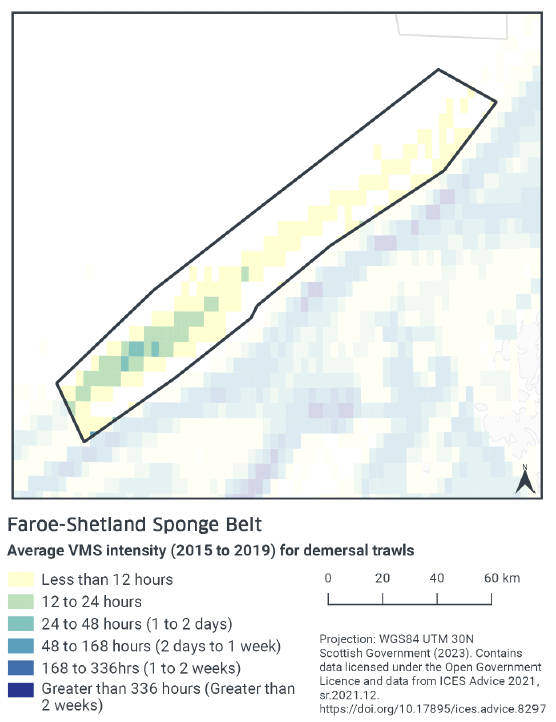
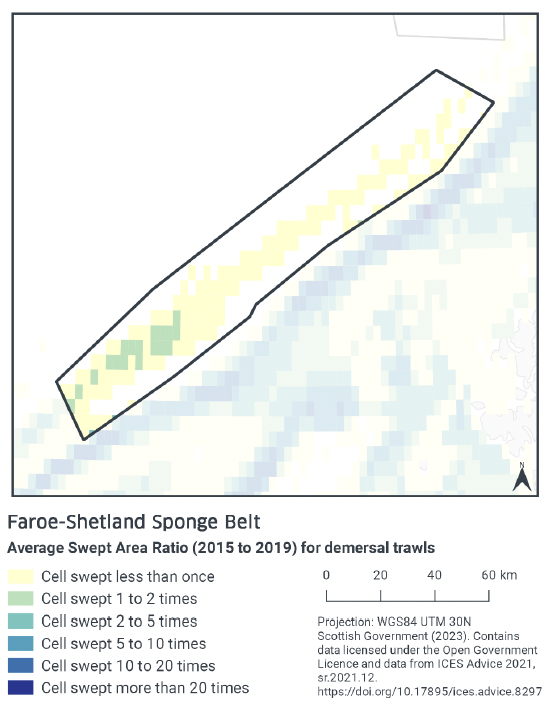
3.2.4 Demersal Seines
Danish Seine was the only seine gear type found to operate within the Faroe Shetland Sponge Belt NCMPA between 2015 and 2019 (Table 1). These seines target demersal fish.
Based on the VMS, demersal seine activity within Faroe-Shetland Sponge Belt NCMPA occurred at less than 12 hours per year per grid cell within a small area in the centre of the site, (Figure 3). Swept-Area Ratio (SAR) information averaged over the same time period shows similar patterns of fishing intensity as the VMS data Figure 3. The VMS data shows no seine activity has occurred in the site from 2016.
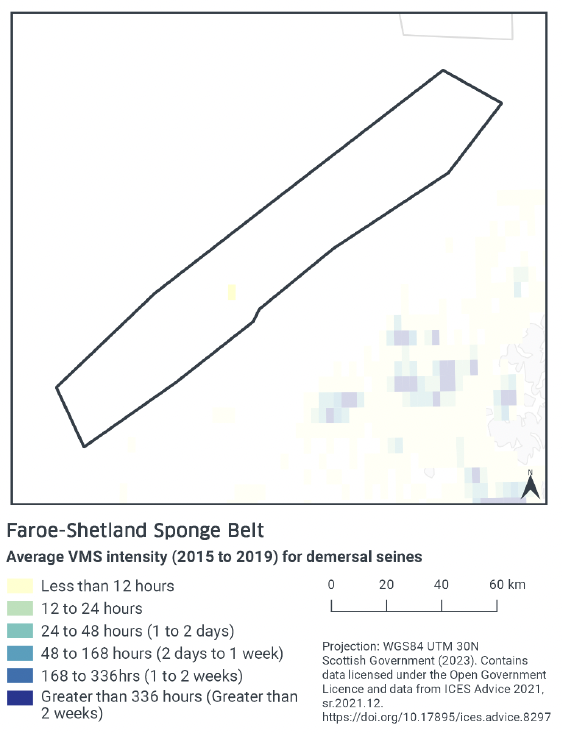
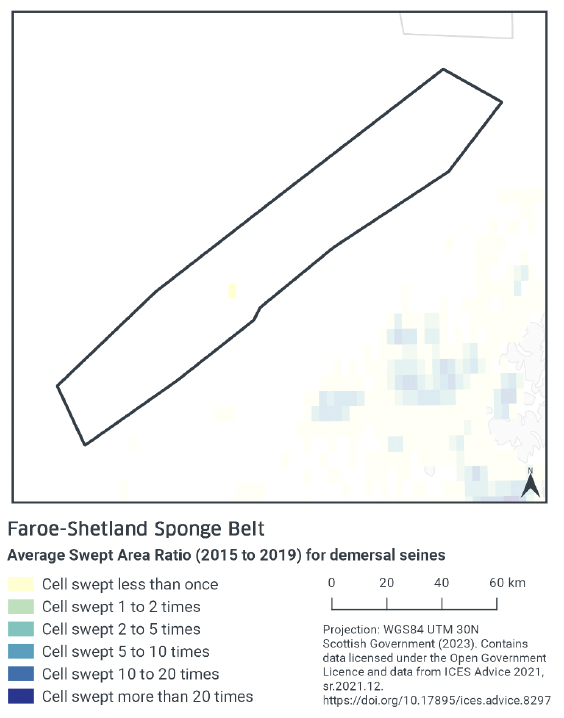
3.2.5 Anchored nets/lines
The aggregated gear method of anchored nets/lines includes multiple gears that operated within the Faroe-Shetland Sponge Belt NCMPA between 2015 and 2019. These include set gillnets, set longlines and longlines (not specified) (Table 1). The target species for these gear types are demersal fish. Similar pressures are exerted by the different gears used for anchored nets/lines fishing, subsequently the aggregated gear type of ‘anchored nets/lines’ was used to map activity across the site.
Based on the VMS, anchored nets/lines activity within Faroe-Shetland Sponge Belt NCMPA is concentrated along the southern boundary. This is reflective of the site bathymetry and the associated restrictions on set net activity below 600 m (see 3.2.1). Activity peaks in the south west corner of the site at 48 to 168 hours per year per grid cell between 2015-2019, (Figure 4) with activity along the southern boundary occurring at less than 12 hours per year. The remainder of the site has no anchored nets/lines fishing activity.
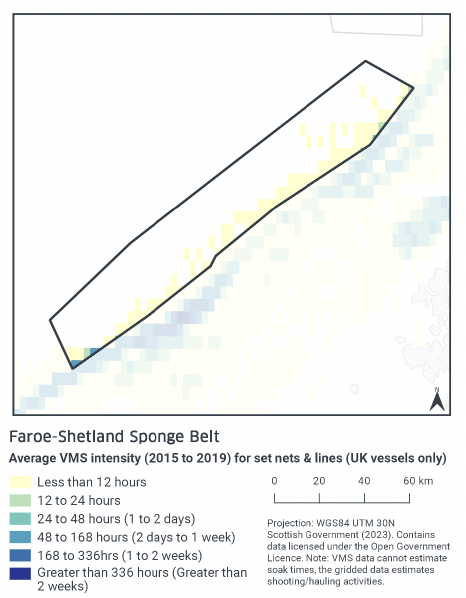
3.2.6 Summary of fishing activity within Faroe-Shetland Sponge Belt NCMPA
Demersal mobile and demersal static fisheries were found to operate in the site with demersal trawl occurring throughout the centre of the site and anchored net/line activity along the southern boundary. Demersal seine was found at low levels, and VMS showed this had not occurred since 2015.
3.3 Fishing activity effects overview
The following sections explore the impacts associated with demersal mobile (demersal trawl and seines) and demersal static (anchored nets/lines) fishing activity within the Faroe-Shetland Sponge Belt NCMPA that were identified as capable of impacting the protected features. The pressures considered in the following sections are:
- Abrasion/disturbance of the substrate on the surface of the seabed;
- Changes in suspended solids (water clarity),
- Penetration and/or disturbance of the substrate below the surface of the seabed, including abrasion;
- Removal of non-target species; and
- Smothering and siltation rate changes (light).
All five pressures considered to be exerted by demersal trawls and demersal seines were considered capable of impacting deep-sea sponge aggregations, offshore subtidal sands and gravels and ocean quahog aggregations features within Faroe-Shetland Sponge Belt NCMPA. Removal of non-target species and abrasion/disturbance of the substrate on the surface of the seabed were pressures also exerted by anchored nets/lines.
Given the similarity between ‘abrasion/disturbance of the substrate on the surface of the seabed’ and ‘penetration and/or disturbance of the substrate below the surface of the seabed’, these two pressures are considered together in the text below.
Information on the impacts of demersal trawls and demersal seines on the protected features is presented below and is informed by the JNCC and NatureScot Fisheries Management Guidance document for Arctica islandica, JNCC and NatureScot Fisheries Management Guidance document for Offshore subtidal sands and gravels, JNCC Marine Pressures-Activities Database v1.5, JNCC fisheries management options paper (2014) and Advice on Operations package for the site.
3.3.1 Summary of impacts associated of demersal mobile gear on Faroe-Shetland Sponge Belt NCMPA protected features
Towed bottom fishing gears (including demersal trawls and seines) are used to catch species that live in, on or in association with the seabed and therefore are designed to remain in close contact with the seabed. That interaction with the seabed can lead to disturbance of the upper layers of the seabed. As a relative comparison of gear types, otter trawls tend to have less physical impact on the seafloor than the beam trawls (and dredges) with their heavy tickler chains, although the doors of an otter trawl do create recognisable scour of the seabed ((Hinz, Murray, Malcom, & Kaiser, 2012); (Polet & Depestele, 2010); (Lart, 2012);(Paschen, Richter, & Köpnick, 2000)). Benthic seines are generally of lighter construction as there are no trawl doors or warps, resulting in less disturbance of the seabed than trawling. The magnitude of the immediate response to fishing disturbance, cumulative effects and recovery times varies significantly according to factors such as the type of fishing gear and fishing intensity, the habitat and sediment type, levels of natural disturbance and among different taxa ((Collie, Hall, Kaiser, & Poiner , 2000); (Boulcott, Millar , & Fryer, 2014);(Kaiser, et al., 2006); (Hinz, Prieto, & Kaiser, 2009); (Kaiser M. J., Collie, Hall, Jenning, & Poiner, 2003)).
Ocean quahog are classed as having medium sensitivity to the pressure removal of non-target species (including lethal) in FeAST[2]. Garcia et al., (2006) investigated effects of scallop dredging on benthic communities off western Iceland using bycatch data from scallop stock assessment surveys and commercial scallop fishery effort data. Their results showed that ocean quahog was the 11th most prevalent species in the bycatch in terms of biomass and was present in 11% of tows.
Hamon et al. (2020) report ocean quahog as being sensitive to demersal seine fishing due to their capture as bycatch in the southern North Sea, however, this assessment is associated with uncertainty due to the sampling technique not being representative of deep burrowing species and larger epifaunal species. Overall, demersal seines may have a relatively lower impact on ocean quahog compared to other demersal towed gears, as the gear is lighter and has no trawl doors or warps.
Evidence suggests that ocean quahog can be caught or damaged by beam trawls (Klein & Witbaard, 1993; Witbaard & Klein, 1994), with an individual pass of the gear causing around 20% mortality (Bergman & van Santbrink, 2000). This has been suggested as the cause of an observed decline in abundance over the last century in the south-eastern North Sea (Rumohr et al., 1998). A study in Dutch waters showed that ocean quahog population density was inversely related to beam trawling effort (Craymeersch et al., 2000).
The JNCC and NatureScot Fisheries Management Guidance document for Arctica islandica states that demersal towed and hydraulic gears that penetrate the sediment (beam trawls, dredges and hydraulic gears including those operated by divers) are likely to reduce the abundance of ocean quahogs. The degree of impact will depend on the intensity of fishing.
There is some evidence that otter trawl doors may impact ocean quahogs by bringing them to the surface (Rumohr & Krost, 1991), however there is insufficient evidence to assess the mortality caused by this gear at a population level. No evidence was found on the effects of shellfish dredging. However, the physical effects of scallop dredging on seabed sediments are similar to those of beam trawls (penetration to depths >5 cm) and so the effects on ocean quahog are likely to be similar. Hydraulic gears penetrate sediments more deeply than other gears and so could be expected to cause a greater mortality, particularly where ocean quahog is the target species (although there is no known direct exploitation of the species in the UK).
Studies on deep-sea sponge aggregations have found that trawling damages, displaces and removes sponges through direct physical impact, as well as from disturbed sediment resettling and causing smothering beyond the path of the trawl itself (ICES, 2007; ICES 2010; OSPAR, 2010b). Deep-sea sponges have some capacity for recovery from mild damage, but significant disturbance, damage or smothering may result in sponges being unlikely to survive (ICES, 2007; ICES 2010).
There are currently no direct studies on the physical impacts of demersal seines. Modelling studies suggest that demersal seines have a large overall footprint (i.e. the surface area covered during one hour fishing) (Eigaard, et al., 2016). Hiddink, et al., (2018) suggest that depletion of biota is highly correlated with seabed penetration depth by trawls. Seines lack the heavy gear components (e.g. otter doors, trawl shoes) of other demersal mobile gears ((Suuronen, et al., 2012) ;(Donaldson, Gabriel, Harvey, & Carolsfield, 2010)) and therefore, despite the relatively large footprint, impacts associated with penetration into the sediment are likely to be lower. Eigaard, et al., (2016) modelled surface (<2cm) and subsurface (>2cm) impacts and found that demersal seines have some of the smallest proportions of subsurface impact.
Siltation rate changes (including smothering) may result from physical disturbance of the sediment, along with hydrodynamic action caused by the passage of towed gear, leading to entrainment and suspension of the substrate behind and around the gear components and subsequent siltation. The quantity of suspended material, its spatial and temporal persistence and subsequent patterns of deposition will depend on factors associated with the gear (such as type/design, weight, towing speed), sediment (particle size, composition, compactness), the intensity of the activity and the background hydrographic conditions. Sediment remobilisation and deposition can affect the settlement, feeding, and survival of biota through smothering of feeding and respiratory organs. Prolonged exposure of an area to the pressure may result in changes in sediment composition.
Bycatch (i.e. discarded catch) is associated with almost all fishing activities and is related to factors such as the gear type and its design (i.e. its selectivity), the targeted species and effort. Benthic trawls most frequently result in bycatch of fish, crustaceans and other invertebrates ((Gubbay & Knapman, 1999)(Sewell & Hiscock, Effects of fishing within UK European Marine Sites: Guidance for nature conservation agencies, 2005); (ICES, 2013); (Pierpoint, 2000); (Bergmann & Moore, 2001);(Catchpole, Frid, & Gray, 2005); (Tulp, Piet, Quirijns, Rijnsdorp, & Lindeboom, 2005)). There are relatively few studies of the non-fish bycatch composition from demersal seines, however, it is probably similar to that of demersal trawls e.g. crustaceans and other invertebrates, etc, although quantities of such bycatch are likely to be lower than that of other gear types such as beam trawls ((Suuronen, et al., 2012); (ICES, 2011); (Donaldson, Gabriel, Harvey, & Carolsfield, 2010)(Walsh & Winger, 2011)).
As with demersal trawls and dredges, demersal seines may impact the structure and function of sedimentary habitats and the long-term survival of their associated species. There are currently no direct studies on the physical impacts of demersal seines. Modelling studies suggest that demersal seines have a large overall footprint (i.e. the surface area covered during one hour fishing) (Eigaard et al. 2016). Hiddink et al. (2017) suggest that depletion of biota is highly correlated with seabed penetration depth by trawls. Seines lack the heavy gear components (e.g. otter doors, trawl shoes) of other mobile demersal gears (Suuronen et al. 2012; Donaldson et al. 2010) and therefore, despite the relatively large footprint, impacts associated with penetration into the sediment are likely to be lower. Eigaard et al. (2016) modelled surface (<2 cm) and subsurface (>2 cm) impacts and found that demersal seines have some of the smallest proportions of subsurface impact.
In general, the impact of demersal mobile gear on sand and gravel sediments is relatively well understood. The extent to which the gear impacts on sand and gravel sediments can vary considerably, according to the type of gear, the intensity of fishing and the sediment composition. Trawling and dredging tends to cause increased mortality of fragile and long-lived species and favour opportunistic, disturbance-tolerant species, however, the tolerance to disturbance is linked to the energy levels of the area.
In higher energy locations, fauna tend to be more adapted to disturbance and as a result tend to be more tolerant of fisheries related disturbance than lower energy locations (Dernie et al., 2003; Hiddink et al., 2006; Kaiser et al., 2006). Stable gravels often support a ‘turf’ of fragile species which are easily damaged by trawling and recover slowly (Collie et al., 2005; Foden et al., 2010). EUSeaMap predicts a low level of energy at the seabed within Faroe Shetland Sponge Belt NCMPA, suggesting a lower tolerance to the pressures to which the habitats are exposed.
Given the evidence outlined above regarding the physical impacts of gear interacting with the seabed, demersal trawling alone at the current level of activity carry a risk of hindering the achievement of conservation objectives for ocean quahog, deep-sea sponge aggregations and offshore subtidal sands and gravels. Demersal seine alone at current level of activity also carry a risk of hindering the achievement of conservation objectives for deep-sea sponge aggregations. Accordingly, Scottish Ministers conclude that demersal trawling and demersal seining alone are capable of impacting the protected features and, at current levels of activity, would or might hinder the achievement of conservation objectives of the site for Faroe-Shetland Sponge Belt NCMPA.
3.3.2 Summary of impacts associated with demersal static gear on Faroe-Shetland Sponge Belt NCMPA protected features
Static gears do not generally create the type of pressures to which ocean quahog aggregations are sensitive (sub-surface abrasion) and so they are unlikely to have any effect. Offshore subtidal sands and gravels are not considered sensitive to static gear activity.
Abrasion/disturbance or penetration of the substrate on the surface of the seabed can result from surface disturbance caused by contact between the nets or lines themselves and any footropes and anchors. This is most likely to happen during retrieval of the gear if it is dragged along the seabed before ascent, although disturbance of the seabed can occur while the gear is fishing if movement (particularly of any anchors) occurs during rough weather, for example, or otherwise. Small vessel anchors have been found to cause surface ‘scars’ of typically 1-4 m2 (Collins, Suonpaa, & Mallinson, 2010). Such physical disturbance can result in epifauna, especially emergent species such as erect sponges and coral, being dislodged (including snagged in the net) or damaged, although there are limited studies of such effects (Auster & Langton, 1999; Coleman, Hoskin, von Carlshausen, & Davis, 2013; Grieve, Brady, & Polet, 2014; Sewell and Hiscock, 2005; Polet and Depestele, 2010; Lart, 2012; Suuronen et al., 2012).
The deep-sea sponge aggregation feature is considered to be sensitive to static gear activity, notably because sponges may become caught or entangled in static gears and damaged on the seabed or brought to the surface. In certain conditions, for example during retrieval, static gears may move laterally across the seabed resulting in impacts (Sampio et al,. 2012; Ewing and Kilpatrick, 2014). By-catch by longliners of hexactinellid and demospongid sponges has been documented within the Northeast Atlantic (Muñoz et al., 2011) and in the Antarctic (Bowden, 2010). While the extent of damage caused by individual static gear fishing events is likely to be lower than that for trawling (Pham et al., 2014), the effect of cumulative damage may be significant.
Given the evidence outlined above regarding the physical impacts of gear interacting with the seabed, demersal static gear alone, at current levels of activity carry a risk of hindering the conservation objectives for deep-sea sponge features at current levels of activity. Accordingly, Scottish Ministers conclude that demersal static gear (anchored net/line) activity alone at current levels would or might hinder the achievement of the conservation objectives of deep-sea sponge aggregations for Faroe-Shetland Sponge Belt NCMPA.
3.4 Part B Conclusion
The assessment of impact of fishing pressures at current activity levels on the deep-sea sponge aggregations, ocean quahog aggregations and offshore subtidal sands and gravels features of Faroe-Shetland Sponge Belt NCMPA has indicated that demersal trawling, demersal seining and anchored nets/lines activity would or might hinder the achievement of the conservation objectives for the site. As such Scottish Ministers conclude that management measures are required to restrict demersal trawling, demersal seining and anchored nets/lines within Faroe-Shetland Sponge Belt NCMPA. Section 5 contains further details on potential measures.
Contact
Email: marine_biodiversity@gov.scot
There is a problem
Thanks for your feedback